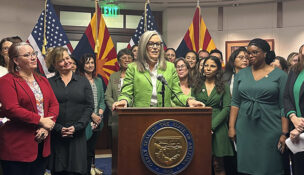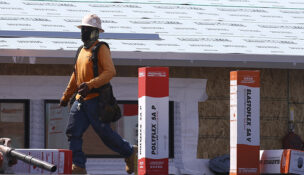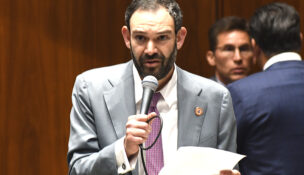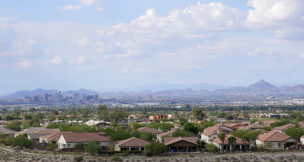Report: Arizona in top 10 for increase in carbon dioxide emissions
Arizona Capitol Reports Staff//June 23, 2006//[read_meter]
Report: Arizona in top 10 for increase in carbon dioxide emissions
Arizona Capitol Reports Staff//June 23, 2006//[read_meter]

FYI: Arizona’s overall carbon-dioxide emissions rose to 87.6 million tons from 15.5 million tons in the four decades surveyed, a fivefold increase.
Talk about greenhouse gases is in the air, and it’s not just coming from Al Gore.
The Arizona Public Interest Research Group released a report this month that says Arizona ranks among the top 10 states for largest increase in carbon dioxide emissions from 1960 to 2001. Carbon dioxide is a greenhouse gas thought to be responsible for global warming.
Later this month, a 34-member climate-change advisory group appointed by Governor Napolitano is expected to issue a report on its own findings. The panel — made up of environmentalists, government officials and business leaders — met for the final time June 22.
The Arizona PIRG report, “The Carbon Boom,” dovetailed with the release of similar reports by other PIRG chapters around the country. In Arizona, the report said, two sources accounted for more than 90 percent of the increase in carbon-dioxide emissions: motor vehicles and coal-fired generating stations.
Hotter summers ahead
Diane Brown, Arizona PIRG’s executive director, said global warming spurred by an increase in greenhouse gases would mean hotter summers in the already hot Arizona desert, and then some.
“Many people think one or two degrees, when it’s already 110, isn’t going to change day to day life,” Ms. Brown says. “However, when you look at the ramifications, particularly in Arizona, we should be concerned about future water shortages and extreme droughts.”
Those degrees of additional heat, she added, can lead to more heat-related illnesses and stress.
According to the report, Arizona’s overall carbon-dioxide emissions rose to 87.6 million tons from 15.5 million tons in the four decades surveyed, a fivefold increase. The figures come from data compiled by the U.S. Department of Energy’s Oak Ridge National Laboratory, a PIRG news release said.
Texas had the largest carbon-dioxide output of any state in 2001, the latest year for which data are available — some 668.5 million tons, up from 240.7 tons in 1960. During that time, the United States as a whole saw carbon dioxide emissions nearly double, going from just under 3 billion tons to 5.7 billion tons.
Ms. Brown said PIRG seeks less reliance on energy sources like oil (including gasoline for automobiles) and coal for electricity, and greater reliance on energy sources that don’t create greenhouse gases.
Without change, she said, “Arizona’s rapidly increasing population will further exacerbate the global-warming problem.”
In addition, she said, more energy-efficient homes could be built and equipped with more energy-efficient appliances, though some standards already exist. The state also could take steps to promote cleaner-burning vehicles like hybrids, she said.
H2429 offers tax credits for solar installations
Renewable resources like solar and wind power should be encouraged, Ms. Brown said, citing one bill recently passed by the Legislature. H2429 would, among other things, offer tax credits for solar-energy installations.
In addition, Ms. Brown gave high marks to the Arizona Corporation Commission for proposing that 15 percent of electricity generated by utilities like Arizona Public Service and Tucson Electric Company come from renewable sources by 2025.
Ms. Brown, however, criticized Salt River Project — which the commission does not regulate — for moving too slowly in cutting back on energy generated from its coal-fired power plants. The PIRG report said more than half the increase in Arizona’s carbon dioxide emissions since 1960 has come from burning coal. After three large coal-fired plants were built in Coconino County around the mid-1970s, carbon-dioxide emissions from coal nearly quadrupled, according to the PIRG report.
SRP operates the plants, known collectively as the Navajo Generating Station, and has a 21 percent stake, SRP officials said.
Referring to SRP, Ms. Brown said: “They need to be increasing their amount of solar, wind and other clean-energy sources. They have adopted a policy that in essence wouldn’t move them from where they are today for another decade.”
SRP officials disagreed with the characterization.
“SRP is making substantial investments in renewables and research and development to respond the climate-change challenges,” said Kevin Wanttaja, SRP’s manager of environmental services.
The SRP board, he added, voted to make renewable energy sources “15 percent of our portfolio by 2025.” That puts the company, a quasi-governmental entity, on track with the Corporation Commission’s proposals, Mr. Wanttaja said.
“So our plan is on par with the investor-owned utilities in the state,” he said.
Report due June 30
The governor’s climate change panel’s final meeting was at SRP headquarters in Tempe. Its report is expected June 30.

















